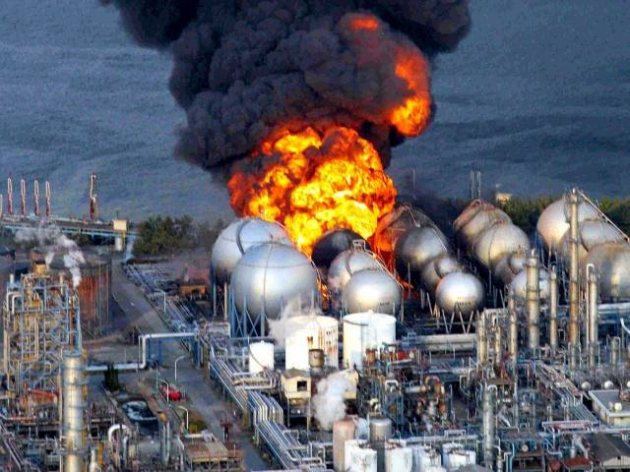
America lives in the shadow of 9-11.
Japan lives in the shadow of a different kind of national disaster, commonly called 3-11.
On March 11, 2011, an earthquake of unprecedented strength rocked the country. The massive tremor, which registered 9.0 on the Richter Scale, generated a tsunami that in places topped 130 feet. It inundated 200 square miles of coastline and traveled up to six miles inland. More than 22,000 people were left dead or missing, and over a million buildings were destroyed.
The most consequential damage happened at the Fukushima Daiichi nuclear power plant on the coastline northeast of Tokyo.
At first it seemed that all would be well. The six reactors survived the quake and began automatic shutdown, just as they were designed. But they were not designed to survive what happened next. A towering mass of water overtopped the protective seawalls and poured into the facility. The water compromised the backup systems, diesel generators, and – most ominously – the electrical equipment designed to monitor the reactors. Now the workers were in the dark, literally and figuratively. They couldn’t tell what was happening and couldn’t see what to do next. How could they cool the reactor fuel rods to ensure a safe shutdown?
Mark J. Ravina, a professor at the University of Texas at Austin and an expert on modern Japan, points out that the accelerating disaster exposed significant failures in leadership – not only within the walls of the plant, but all the way to the halls of the prime minister.
When the Fukushima engineers consulted the standard atomic safety manual for what to do next, they were alarmed to discover that there was no procedure for a prolonged total loss of power. They had just experienced what the industry calls a Beyond Design Basis event. In other words, the system worked exactly as designed. It just wasn’t designed for a 9.0 earthquake and tsunami.
Fires and explosions damaged two of the reactors. The engineers decided to pump in seawater to cool the fuel rods. It was a desperate measure.
Where were the top leaders while these decisions were being made? One was at an offsite meeting. The other, Masataka Shimizu, was on vacation. He struggled for hours to reach the Fukushima plant. When he finally arrived and grasped the significance of the disaster, Shimizu held a press conference. Then he went into hiding for a month, leaving mid-level managers to handle the crisis.
They struggled. It quickly became evident that the contaminated seawater had to be released. Some 10,000 tons of radioactive water was pumped back outside, where it generated an environmental catastrophe that necessitated the evacuation of 165,000 nearby residents. The cleanup is still underway 11 years later and is expected to go on for decades.
An investigative commission later determined that what happened at the Fukushima plant was a “profound manmade disaster.” If the original plans had included a higher seawall – a comparatively inexpensive option – damage would have been limited. Politicians and nuclear energy officials could have worked together as partners. But what the public saw instead was finger-pointing, dishonesty, and incompetence – all at the expense of national safety.
Public confidence in nuclear energy quickly imploded. Before the earthquake, Japan boasted 54 reactors that provided 25% of the nation’s electricity. Today just four reactors are operating, generating only 4% of what is needed to keep the lights on.
Ravina says that Japan’s current leaders are hoping that people will forget 3-11 ever happened, and in particular the mistakes that made it worse. But that, he suggests, is a nothing but a hopeful fantasy.
That’s because people always remember how leaders lead in the midst of crises.
And whether we like it or not, people will always have their eyes on us when we’re suddenly faced with tough times.
Whether you’re an executive guiding a corporation through transition, a parent dealing with an energetic Kindergartner, an officer leading troops into battle, a summer camp counselor trying to manage a cabin full of middle schoolers, or someone endeavoring to accomplish anything at all that will make a difference in the world, you will sooner or later experience a Beyond Design Basis event – something equivalent to a 9.0 earthquake for which no one has made adequate preparations.
The people of Japan realize that the ground is going to move from time to time. That’s what it means to live at the edge of a tectonic plate.
But we’re often caught off guard when it seems that the “secure place” we’ve been standing has been badly shaken.
How should we respond?
We begin by affirming that there is Someone who never moves. Then, with humility that sees those around us as partners and not rivals, and an eagerness to pursue the common good instead of personal security, we trust that God is preparing a new place for us to stand.
And we cling to the words that inspired Martin Luther to write “A Mighty Fortress is Our God:”
God is our refuge and strength, a very present help in trouble.
Therefore we will not fear, though the earth should change,
Though the mountains shake in the heart of the sea;
Though its waters roar and foam, though the mountains tremble with its tumult…
The Lord of hosts is with us; the God of Jacob is our refuge.
(Psalm 46:1-3, 7)
If your world is being shaken, the Lord of hosts is where you will find grace, confidence, and hope.
All other ground is sinking sand.
